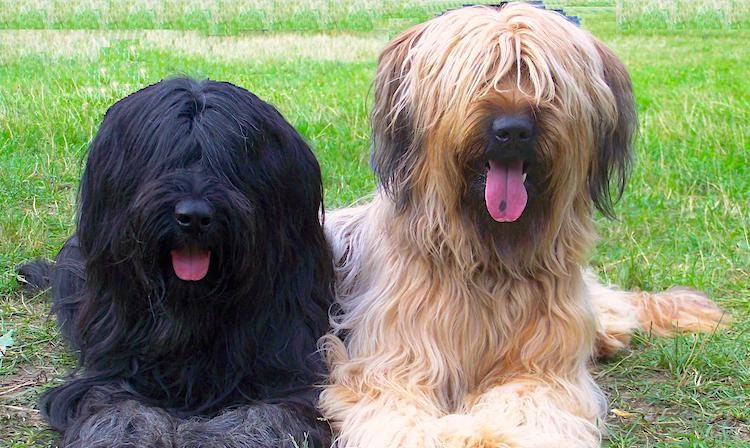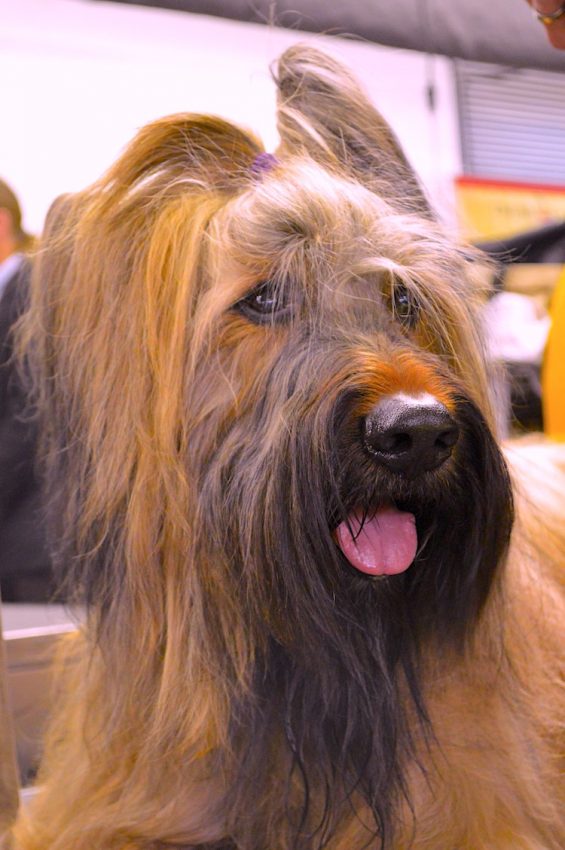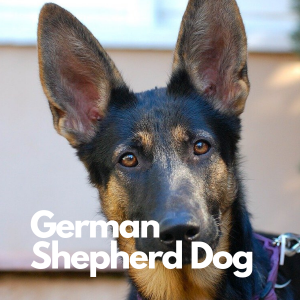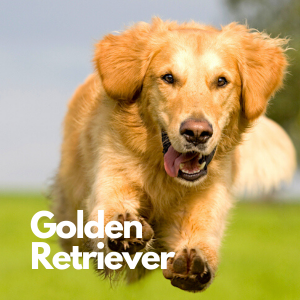
Herding
55-100 lbs.
22-27 in.
10-12 years
1. Key Characteristics of Briards
The Briard is a large, powerful herding dog with excellent watchdog instincts and a superior sense of hearing.
The dog’s long, plush, wavy double coat comes in shades of black, gray and tawny, with white sometimes mixed in. Darker colors can appear around the mouth or ears.
The large, rectangular head of a Briard is adorned with high-set ears covered with hair. This head and ear hair can make it look as though the dog is wearing pigtails.
The eyes are either black or dark brown, and the nose is square and black.
2. Where Briards Come From
Briards are old French dogs with depictions dating to the 8th century, when their likeness was woven into tapestries.
Initially used as defenders against poachers and wild predators, Briards have since been used for herding and guarding.
The first litter of American Briards was documented in 1922 from a breeder in Massachusetts. The Briard Club of America was founded in 1928, the same year the American Kennel Club (AKC) acknowledged and added the breed.

3. How Friendly Are Briards?
Briards are intelligent and eager to learn, and they need patient and consistent training. Start as soon as you add your Briard to the family — because these dogs are so intelligent, they can get bored easily.
Independent thinkers, Briards are reserved with strangers, so leadership is necessary. Without this leadership, Briards can become fearful, unfriendly and even aggressive, but this is rare with proper training and a regular exercise routine.
Briards are dedicated to their family members and sensitive to their people’s emotions. They have an instinctive desire to herd and may nip at heels in an attempt to fulfill their instincts.
Though good with children if properly socialized, Briards don’t respond well to teasing. Slow and controlled interactions with other dogs may be required.
4. Is This the Right Dog for You?
Exercise Needs
HIGH: This active dog breed needs regular exercise to expel energy. Take your adult Briard for long walks or jogs each day to prevent behavior problems. These dogs are active indoors and can do well in apartments if their exercise needs are met.
Many Briards also enjoy swimming, but check the temperature outside first — their double coat may cause them to overheat.
Briards don’t mature until around 18 months, so take care not to over-exercise yours (think short walks, but not long jogs or hiking). The bones are still soft during this time and need gentle exercise as they grow.
Grooming Needs
VERY HIGH: Brush your Briard daily to prevent mats and reduce shedding, and check for any debris picked up outdoors.
Don’t forget to brush the hair around the face and ears — a neglected Briard’s coat can become completely matted, so keep up on the grooming.
Trim any excessive hair between the paw pads and inside the ears regularly.
In addition, trim the double dewclaws when trimming the other nails — they’re usually on the rear paws, with single dewclaws on the front paws. Finally, be sure to clean the teeth regularly.
Health Problems
MEDIUM: The following conditions may affect a Briard:
- Progressive retinal atrophy
- Cataracts
- Hip dysplasia
- Bloat
- Congenital stationary night blindness
- Skin conditions
- Cancer
Ask for medical records or tests on a puppy, the parents or an older dog. These can identify which eye problems may be present.
Congenital stationary night blindness can be tested for, and dogs with this result should not be used for future breeding.
More Stats About Briards
| Friendliness | ★★★★☆ |
| Ease of Training | ★★★★☆ |
| Barking/Howling | ★★★★☆ |
| Shedding | ★☆☆☆☆ |
| Tolerate Being Alone | ★★★☆☆ |
| Very Good With Kids | ★★★★★ |
5. How to Adopt a Briard
Considering this breed’s training and grooming requirements, please carefully consider whether to adopt or buy a Briard — don’t do either on a whim.
Check for an adoptable Briard first. Purebred dogs end up in rescues and shelters every day.
If you decide to contact a breeder, ask for medical tests on the dog’s parents and watch for signs of a puppy mill or an irresponsible breeder.
References
- “Briard.” American Kennel Club. https://www.akc.org/dog-breeds/briard/.
- “History of the Briard.” British Briard Club. 2013. http://www.thebritishbriardclub.org.uk/breed-history.html.
- “Herding Description.” Briard Club of America. 2017. https://www.briardclubofamerica.org/index.php/breed-information/herding-description.
- “Breed Information.” Briard Club of America. 2017. https://www.briardclubofamerica.org/index.php/breed-information/general-information.








